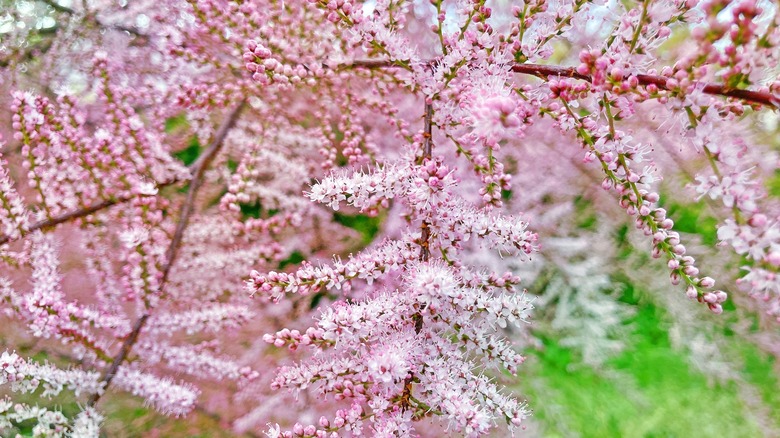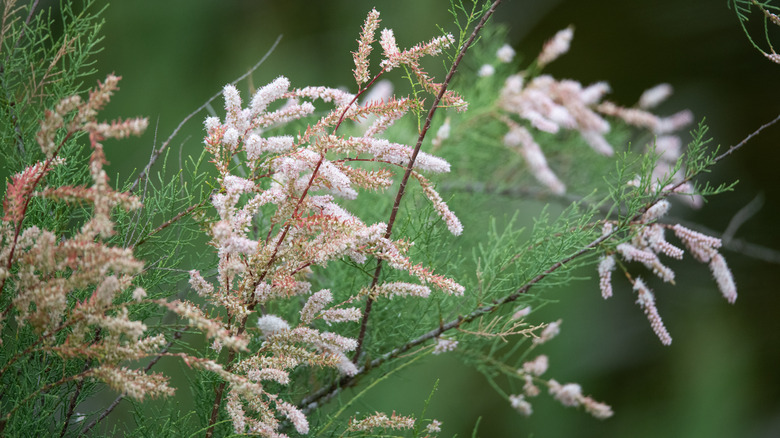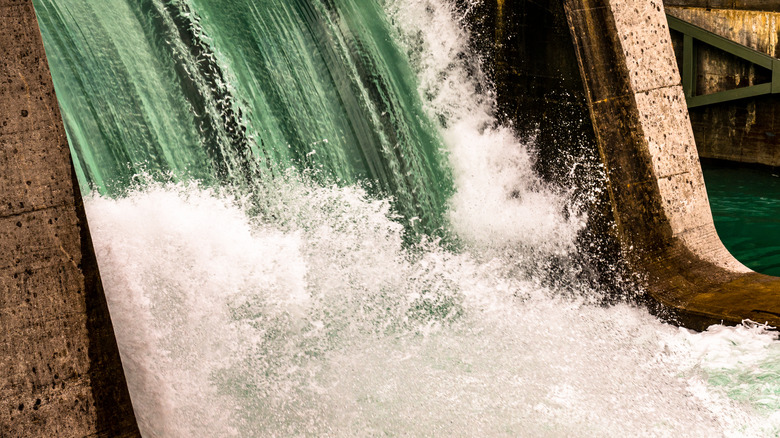Here Is What Makes A Tamarisk Tree Special (And Extremely Invasive)
Tamarisk, also known as tamarix, five-stamen tamarix, or salt cedar, was first introduced to the U.S. as an ornamental plant sometime in the 19th century. Native to Europe and Asia, tamarisk became popular among American gardeners as a windbreak plant as well as a means of controlling erosion alongside riverbanks. The plant has striking characteristics, including scaly foliage, reddish bark, abundant pinkish-white flowers, and a tendency to grow in dense thickets. Its long, spindly branches have been compared to juniper, but despite its similar appearance, tamarisk is a deciduous shrub, not an evergreen or conifer.
Although its ornamental qualities make tamarisk trees stand out, there's one biological factor that makes tamarisk particularly special: salt. Tamarisk plants are referred to as "salt cedars" because their leaves contain salt-secreting glands that allow them to process the high salt content of particularly alkaline soils. This evolutionary trait allows these rhizomatic plants to thrive where other plants may struggle, and that's just what they've done in the West, Southwest, Great Plains, and along the East Coast. Between 1920 and 1960, it's estimated that tamarisk spread from a mere 10,000 acres of territory in the U.S. to nearly 1.2 million acres. Once established in an area, tamarisk behaves as other invasive garden plants do, choking out native vegetation and leaching nutrients and water from the surrounding soils.
What makes tamarisk so invasive?
One reason that tamarisk has been so effective at colonizing areas near rivers and other bodies of water is that tamarisk plants are both halophytes and phreatophytes. A halophyte is a plant that has evolved to tolerate salt, while a phreatophyte is a plant that draws heavily from the water table through deep roots. Tamarisk typically establishes itself in alkaline soil, where most plants can't grow normally, and proceeds to make the alkalinity of the soil worse: their deep taproots draw alkaline water up from the ground, then their leaves secrete the extra salts. When the leaves drop from the tamarisk plant, they add salt back into the surrounding soil, making the soil salinity and alkalinity higher near the surface.
This process can be particularly difficult to contend with in areas where dams limit rivers' flow, as there is less water available to move excess salts out of the soil. Tamarisk also grows very densely, choking out areas where native plants might once have grown. The shrubs are also more fire-resistant than native plants, and typically require multiple applications of herbicide to prevent regrowth. Not to mention the thousands of seeds (up to 500,000!) their fruits produce annually, which spread via air and water and can germinate within 24 hours. These qualities make it easy for tamarisk plants to rank high among invasive plants you should never grow.
How can we control the spread of tamarisk?
Unfortunately, controlling tamarisk spread isn't as easy as keeping other invasive plants from spreading in your home garden. Because tamarisk plants are very tolerant of pruning, limited success has been found using mowing and other mechanical methods of containing spread. Herbicide can be applied to salt cedars via foliar spray or at the stump of a tamarisk tree, but as mentioned above, most herbicidal methods require reapplication due to the tamarisk's tendency toward regrowth.
One unexpected method scientists have used to control tamarisk growth in the U.S. has been to introduce tamarisk beetles into areas where tamarisk trees have supplanted native wildlife. The beetles, native to the same areas as the tamarisk plant, feed on the leaves of the tamarisk tree as larvae and adults and were first released in affected states beginning in the late 1990s. Over time, with repeated defoliation of tamarisk tree leaves, the plants will no longer be able to photosynthesize due to the beetles' eating habits. It's also been suggested that fixing soil alkalinity through controlled flooding of areas affected by tamarisk plants will help reestablish native species.


